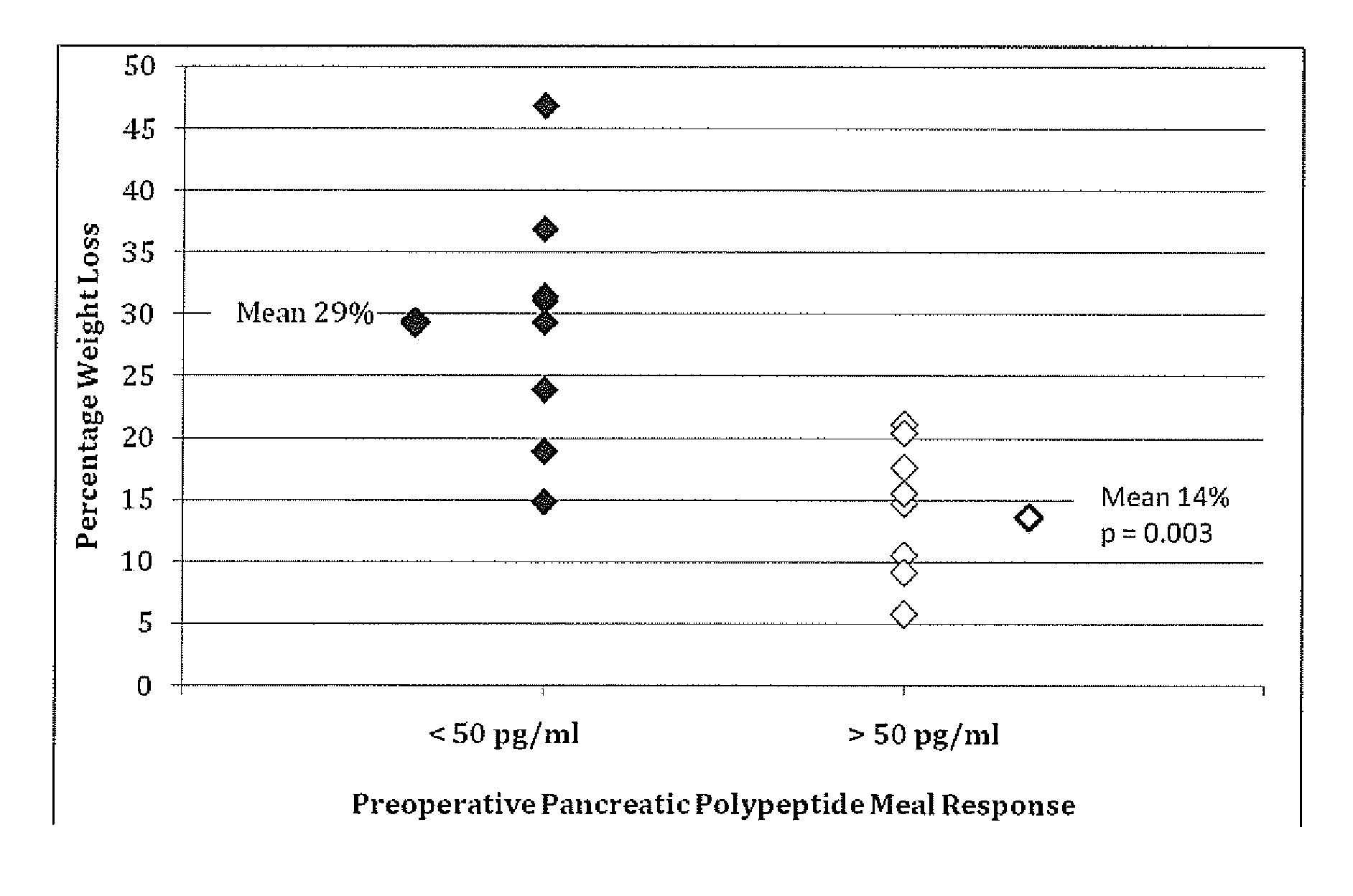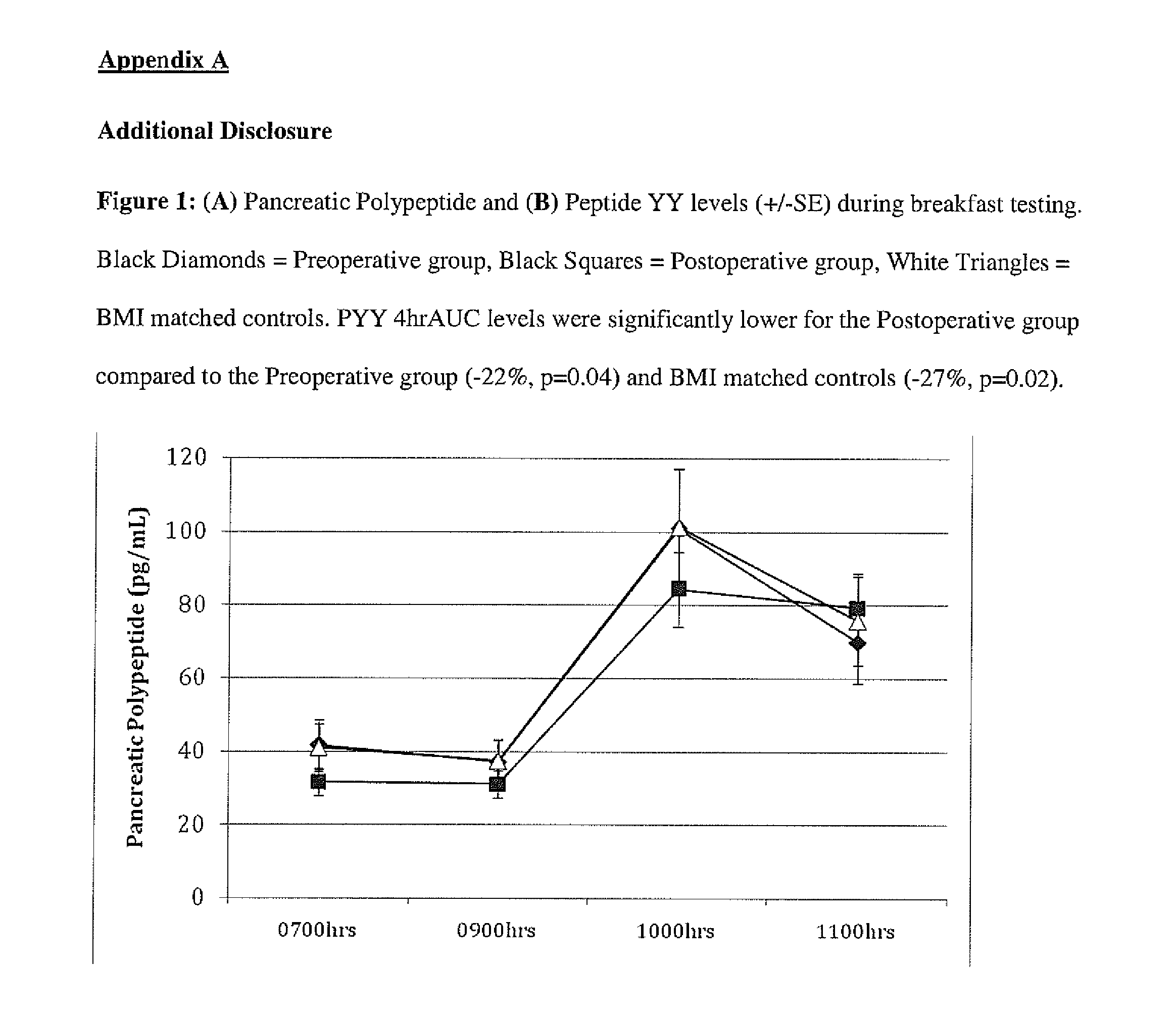Methods for predicting weight loss success
a weight loss success and method technology, applied in the field of methods for predicting weight loss success, can solve the problems of morbid obesity is an extreme health hazard, excess fat storage, weight loss,
- Summary
- Abstract
- Description
- Claims
- Application Information
AI Technical Summary
Benefits of technology
Problems solved by technology
Method used
Image
Examples
example 1
[0050]In the Figure below, the meal response was an average increase in PP concentration of about 50 pg / ml. Those people having a PP concentration below the average went on to have, on average, a higher percentage of weight loss.
[0051]Individuals with a Pancreatic polypeptide meal response (AUC) less than average pg / ml in preoperative testing on average lost twice as the percentage weight loss as those with a response>average pg / ml
[0052]In this case, the average meal response was 50 pg / ml but this can vary somewhat between series of measurements as expected for any hormone assay.
[0053]It is believed that gastric banding reduces pre-prandial hunger and increases postprandial satiety. Several known and potentially many unknown neural and endocrine satiety signals may be responsible for this effect.
example 2
[0054]PP and PYY responses to a standardized meal in a group of patients before gastric banding and a group of patients who have already undergone gastric banding are analyzed to look for a correlation with weight-loss outcome. It is also examined whether PP or PYY concentrations are altered when gastric band pressure is adjusted (an effect known to change satiety).
Prospective Study
[0055]There were 16 obese subjects tested prior to undergoing laparoscopic gastric banding (LAGB) (preoperative group) with their weight-loss results subsequently followed for a mean 48 months (range 18 to 60 months).
Cross Sectional Study
[0056]There were 17 weight-stable subjects who had already undergone LAGB (postoperative group, mean 26 months post-op, range 18 to 36 months). Seventeen controls were BMI matched to the post operative test group (BMI matched control group) to allow assessment of whether hormone serum concentrations were appropriate for body weight or altered by the weight-loss method. Th...
example 3
[0068]A prospective study is used to assess plasma PP and PYY meal responses in 16 obese individuals prior to gastric banding (LAGB). The study examines 17 postoperative individuals who had already achieved mean 28% LAGB-induced weight-loss (range 10% to 38%).
TABLE 1Demographic and weight characteristics for the study subjects.Mean (standard error). Significant and near significantdifferences (unpaired student t-test) are displayed.PreoperativeBMI MatchedPostoperativeTest GroupControlsTest Group(n = 16)(n = 17)(n = 17)P-ValueSex (M:F)3:135:123:14Age (years)41.1(2.1)42.9(2.4)44.5(2.3)BMI (kg / m2)42.6(2.5)*#32.9(1.6)#31.9(1.2)*Both Height (m)1.68(0.03)1.70(0.03)1.67(0.02)Weight (kg)120.5(8.4)*#95.3(4.9)#90.3(5.0)*Both Postoperative BMI33.2(2.5)(kg / m2)Postoperative Weight93.7(5.3)(kg)Preoperative BMI44.2(1.7)(kg / m2)Preoperative Weight125.4(7.0)(kg)Weight-loss (kg)34.7(5.5)35.1(3.1)Weight-loss (%)21.8(2.9)*28.0(1.8)*0.09range6 to 4710 to 38
Results
[0069]In the prospective study, subsequen...
PUM
| Property | Measurement | Unit |
|---|---|---|
| concentration | aaaaa | aaaaa |
| time | aaaaa | aaaaa |
| weight | aaaaa | aaaaa |
Abstract
Description
Claims
Application Information
 Login to View More
Login to View More - R&D
- Intellectual Property
- Life Sciences
- Materials
- Tech Scout
- Unparalleled Data Quality
- Higher Quality Content
- 60% Fewer Hallucinations
Browse by: Latest US Patents, China's latest patents, Technical Efficacy Thesaurus, Application Domain, Technology Topic, Popular Technical Reports.
© 2025 PatSnap. All rights reserved.Legal|Privacy policy|Modern Slavery Act Transparency Statement|Sitemap|About US| Contact US: help@patsnap.com



